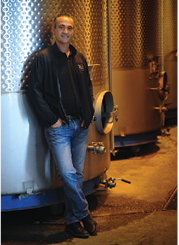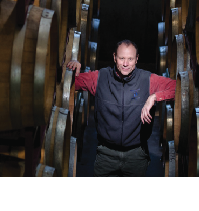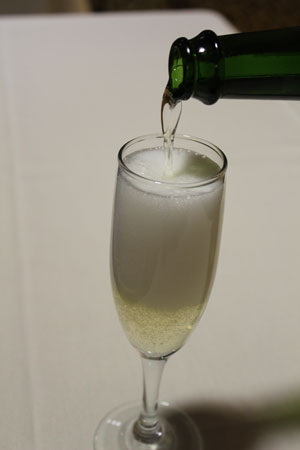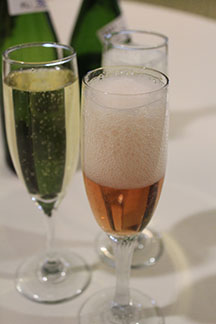These three pros offer up tips to make your own sparkling wine at home.
Steve DiFrancesco is the Winemaker for Glenora Wine Cellars in Dundee, New York.
If you’re going for a classic elegance in your sparkling wine you want very delicate flavors from the grapes because the effervescence is going to elevate the aromatics; that’s why Pinot Noir, Pinot Meunier, Pinot Blanc and Chard-onnay are most commonly used. But for more of an aromatic wine like Prosecco or Sekt, you could use grapes such as Muscat, Traminette, or Riesling and add more sugar at disgorging. Another good option if you live somewhere that can’t grow Pinot or Muscat is Delaware, which is cold tolerant and hardy.
You want crisper grapes with less sugar than for a typical table wine because you only want about 10.5 percent alcohol after primary fermentation. So you must harvest before you pass 19 °Brix. That’s tricky if you’re in a warm area where harvest may be in July.
Primary fermentation can be done in 10 days or so, then that needs to be stabilized and the sulfur needs to be kept low — don’t add more than 40 parts per million after primary and wait to maintain an SO2 level of around 25 ppm or so because you don’t want to prevent the secondary fermentation from taking off. Lower sulfur is tricky, however — it can go bad on you and invite contamination into the wine before you know it.
Sparkling wine is a clean wine with low nutrients and high alcohol, relatively speaking compared to juice, so it’s tough conditions for the yeast. Plus the yeast will be under pressure when fermenting in the bottle, so use a high performance yeast like Lalvin EC-1118 or DV10.
I like to age sparkling wine in the bottle on the lees a year and a half, if not longer. Then I riddle the yeast down into the neck of the bottle and remove it before adding the dosage and capping it again. It will taste OK right away, but it will taste better in a few weeks as the sugar you just added becomes more blended and harmonious with the wine.
 Laurent Gruet is Head Winemaker at Gruet Winery in New Mexico.
Laurent Gruet is Head Winemaker at Gruet Winery in New Mexico.
We use Chardonnay and Pinot Noir to produce all of our sparkling wines. We are very fortunate to have our vineyards situated in the high desert of New Mexico where we have a consistent climate of hot days and cold nights, which creates a great balance for the growth of our grapes. Most of our wines are blends, excluding our Blanc de Blancs, and Grand Reserve. I believe the best Champagnes in the world are blends because they create the best aromas and flavors. This is what I try to accomplish day in and day out with my wines.
We look for a balance between acidity, sugar and the pH to produce our world-class sparkling wines. We typically harvest a lot earlier for sparkling wine than for table wine. We pick our grapes when they are around 17 to 19 °Brix to keep a high acidity. We also chaptalize our wines like they do in Champagne.
I use a traditional Champagne yeast. You need a strong yeast that is able to kill the wild yeast and ferment in the bottle without exposing itself to oxygen.
The aging potential of our sparkling wines vary from 3 to 10 years; the reason being is acidity, and the fact that we do not use malolactic fermentation.
Making sparkling wine is not simple. The best advice I can give is stay away from malolactic fermentation, use traditional grapes and don’t harvest too late. Late harvest wine won’t ferment in the bottle, especially if it is over 13% alcohol.
 Mark Wagner founded Lamoreaux Landing Wine Cellars in Lodi, New York.
Mark Wagner founded Lamoreaux Landing Wine Cellars in Lodi, New York.
At Lamoreaux Landing Wine Cellars we don’t make sparkling wine every year, in part because it is so labor-intensive. We use the méthode Champenoise style and, for us, it’s all hand labor because we don’t have enough production to be very efficient. Our customers really like it, but is it a real moneymaker for the winery? Probably not.
The growing season largely determines whether we make a sparkling wine or not. What we’re looking for is the right sugar and acid balance. The grapes can’t be above 18 °Brix. Some years there is a shorter growing season and the grapes won’t get as ripe, so then it makes sense for us to make sparkling wine.
We make sparkling wines using Chardonnay and Pinot Noir. We have made blanc de blancs, blanc de noirs and blends with 30 percent Pinot Noir and 70 percent Chardonnay.
The time we wait before secondary fermentation varies, but we try to bottle it before the next harvest season. Then we give it at least another two and a half to three years in secondary before disgorging. Sometimes we let it go five years in the bottle on the lees. The more time it spends on the yeast really helps the texture of the wine so we only disgorge as needed.
My advice for a home winemaker? Go buy it off the shelf; it’s a lot easier. It really is a huge amount of work, but if you can’t fight the urge to try making a bubbly, make sure your corks are appropriate for your bottleneck size so they don’t leak. The other problem to watch out for is making sure you don’t put too much sugar in secondary because that could blow up bottles or blow the caps off. That’s the biggest danger; you don’t want exploding bottles.
While it is a lot of work, it is also really rewarding if you can do it well.

 Laurent Gruet is Head Winemaker at Gruet Winery in New Mexico.
Laurent Gruet is Head Winemaker at Gruet Winery in New Mexico.
 Mark Wagner founded Lamoreaux Landing Wine Cellars in Lodi, New York.
Mark Wagner founded Lamoreaux Landing Wine Cellars in Lodi, New York.



